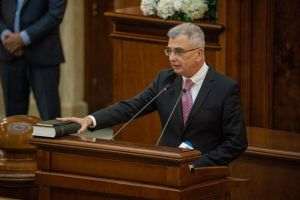A Romanian businessman and a Latvian physicist are about to revolutionize the world mining industry, after they recently registered their invention with the European Patent Office (EPO) of Geneva.
Nicolae Costache is the name of the Romanian originating from Bucharest who manages several mining concessions in Africa and who financed the research of the Latvian physician - B. Voldemars. The researcher resides in Africa, but was born in Riga - the capital of Latvia.
The two met on the coast of Western Africa, from where Nicolae Costache has been running his business for approximately six years, and then began their collaboration on a very ambitious project: patenting a new technology for the extraction of precious and strategic metals from any type of ore, without using cyanides or any other toxic substances.
The application to register the patent in Geneva was submitted on June 1, 2010, on behalf of the two men, by Swiss Law firm "Katzarov", specializing in Intellectual Property Law. The registration of the invention in Geneva occurred just three weeks after the European Parliament passed the bill prohibiting the use of cyanides in mining operations. This has exponentially increased the value of their invention, even though it was very valuable to begin with.
Major mining groups quickly got in on the act, starting intense negotiations to acquire the rights to the new invention.
The European Commission later toned down its stance on the matter, by stating that there was no need for a full prohibition of the use of cyanides in mining (because the European norms in this respect were rather strict), but this did not dent the interest for the new invention.
The Romanian business man claims the secrecy of his patent claim is due to the need to keep the "technological secret". A reason which is perfectly logical, given the potential financial impact of their new invention, which is now in the final testing stage.
BURSA has obtained exclusively, in Geneva, the applications filed to the EPO for the new patent, as well as part of the mail between law firm "Katzarov" and its two clients.
Contacted by "BURSA", Nicolae Costache was very reluctant to speak about the new mining technology which he is looking to patent. He considers that for now, economic secrecy is a strategic need in this case, or as he artfully put it: "Imagine that the CEO of Halliburton (famous American corporation -ed. note) finds out that some smart lad in the countryside has invented a car that works on water instead of gas. Who do you think will disappear first, the young man or his invention?"
After lengthy discussions, both Costache as well as the Latvian Voldemars agreed to give us a short interview.
• The invention
The name of the invention registered by Nicolae Costache - B. Voldemars with the European Patent Office of Geneva sounds rather grandiloquent: "The Voldemars-Costache method for extracting noble metals and other elements through ore disintegration and through the repeated use of a non-toxic technological process". In short, the solution created by the two, proposes the utilization of new physico-chemical processes in the mining industry.
Essentially, the invention consists of using high frequency equipment for breaking down the natural materials into basic particles. After the breaking down of the ore into primary elements, they would be separated based on their chemical properties.
The process has four main stages, programmed by the device patented in Geneva. High frequency is used in each of these four stages. Depending on the properties of the material, disintegration can require from 1 to 10 cycles, and the entire process can last from 30 minutes to 10 hours. This allows the recovery of the various types of materials in the ore, each with its individual properties (density, mass etc.), going from noble metals (gold, silver), to strategic metals (uranium, thorium, wolfram, titanium, columbite, strontium etc.)
The two promoters of the invention are banking on its technical benefits: "The method has industrial applicability, is cheap and can extract as much 95-99.9% of the noble metals in any type of ore."
Nicolae Costache considers that the social benefits are of the invention are just as important: "No toxic substances are used at any of the four technological stages of the disintegration of the ore, such as the controversial cyanide. Our method is 100% ecological".
B. Voldemars completes the statements of his Romanian partner, speaking didactically: "For instance, platinum, titanium and thorium (which is expected to become the main nuclear fuel in the future), are obtained through an extremely costly and lengthy industrial process, which also has a low yield. Using the method we invented, this as well as other important metals, which are hard to extract using conventional methods, can be extracted by repeating the initial disintegration process, but, and I must repeat that, depending on the physical properties of the material. Our technology, which has been tested and works regardless of temperature or of the composition of the ore, can efficiently extract precious as well as strategic metals".
• The solution for the Roşia Montană mining concession
Voldemars has also studied the situation in Romania.
He is familiar with the sensitive issues which are the object of public controversy, including Roşia Montană, which hosts one of the largest unexploited gold deposits in the world. The solution proposed for the exploitation of that gold deposit, involved the use of cyanides, which can affect the environment in the area, and it has caused a huge scandal which has lasted for the last ten years.
The Latvian physicist says that the solution created by him and his associate can be successfully used to exploit that gold deposit: "Indeed, it can be used in the hydrothermal mining deposit of Roşia Montană. This will allow meeting all the environmental standards, and help the company that holds the concession make a bigger profit."
THE BUSINESS STRATEGY
Nicolae Costache and B. Voldemars have drawn up a business plan which includes several stages, which would allow them to exploit their invention. After filing a patent to protect their invention, they are now building in Romania what they call an "experimental station".
They have acquired 20 hectares of land in the county of Hunedoara, where they are assembling an industrial hangar. The disintegration device connected to the computers that control the frequency will process the various types of ore, separating the metals from the other chemical elements.
"The experimental station will be launched at the end of September", said Nicolae Costache. Later, the rights for the use of the patent will be taken out on the international market by a company set up in Romania specifically for this type of transactions, which are targeted at major mining corporations. In other words, the company owned by Costache and Voldemars would come from selling the rights to the patent registered in Geneva.
Overall, Costache seems optimistic: "The use of our ecologic method on an industrial scale involves far lower costs than any of the two mining methods currently used in the industry: the conventional method and the one that involves the use of cyanide."
When asked about the names of the corporations that he has entered negotiations with, the Romanian businessman became secretive and declined to comment.
According to our information, Nicolae Costache and Voldemars are already negotiating with Swedish company "Dacian Mining" AB, with the representatives of "Gabriel Resources" (the majority shareholder of the joint-venture that holds the exploitation license for Roşia Montană), as well as with the British mining group "Target Resources Plc.".
Costache and Voldemars refused to comment the information concerning the negotiations with the aforementioned companies.
THE INVESTOR. Nicolae Costache (foto) was born in Bucharest, but went from the shores of the Dâmboviţa to the African jungle. He controls five mining and diamond concessions in Western Africa, and spends eight months a year in Guinea Bissau, Angola, Sierra Leone, Namibia and Senegal. He does business of tens of millions of Euros in the diamond exchanges of Antwerp and Tel Aviv.
THE SCIENTIST. During the Soviet era, B. Voldemars graduated from the "P.N. Lebedev" Physics Institute of Moscow Science Academy. He already had a degree as a mining engineer. In the 90s, after the end of the Cold War, Voldemars left Moscow, crossed the Pacific and became an accredited researcher at the NASA (the United States Space Agency). The physicist currently resides in Africa.


















































